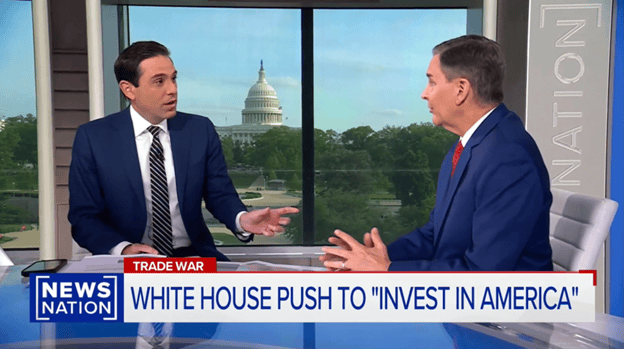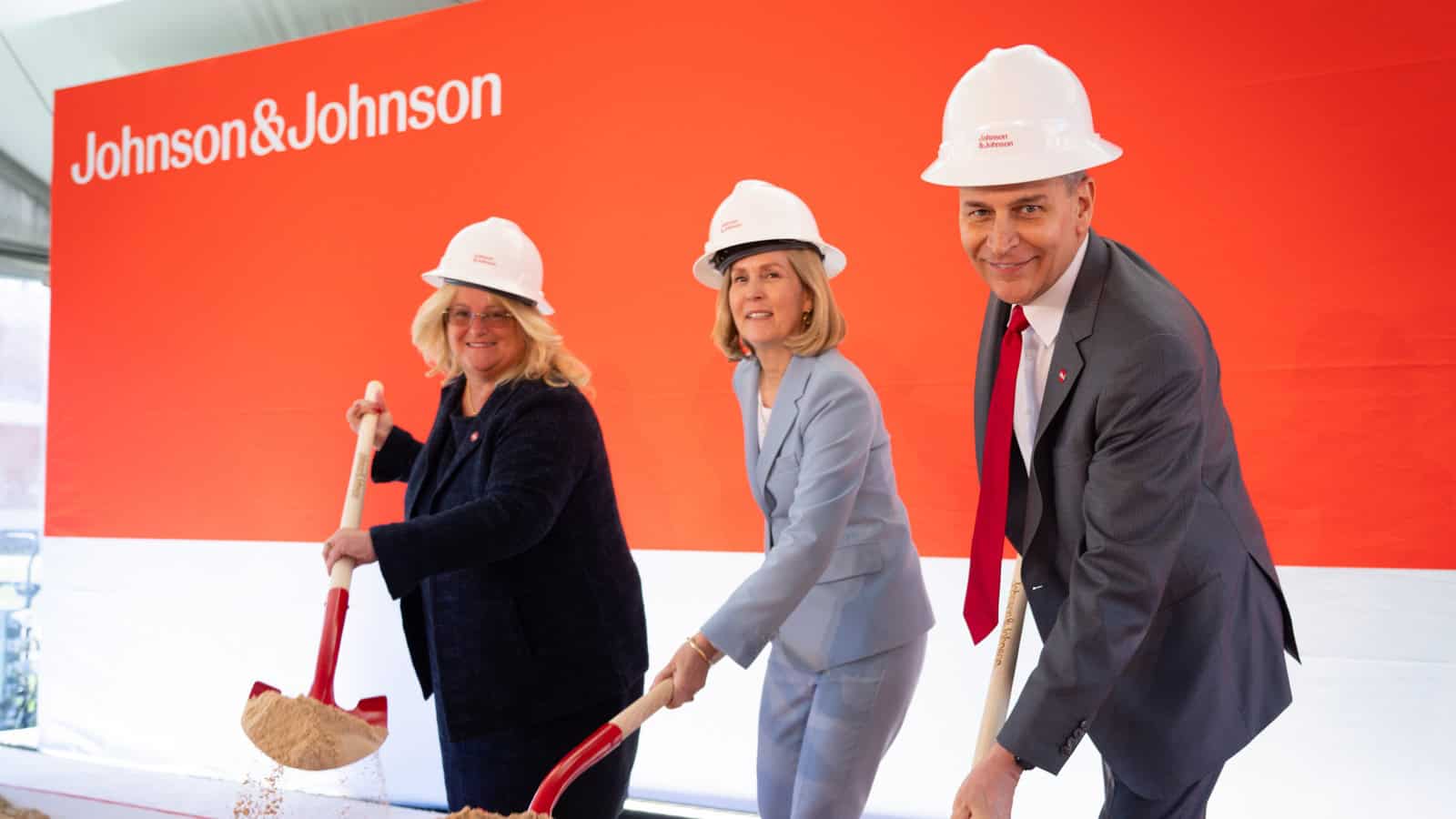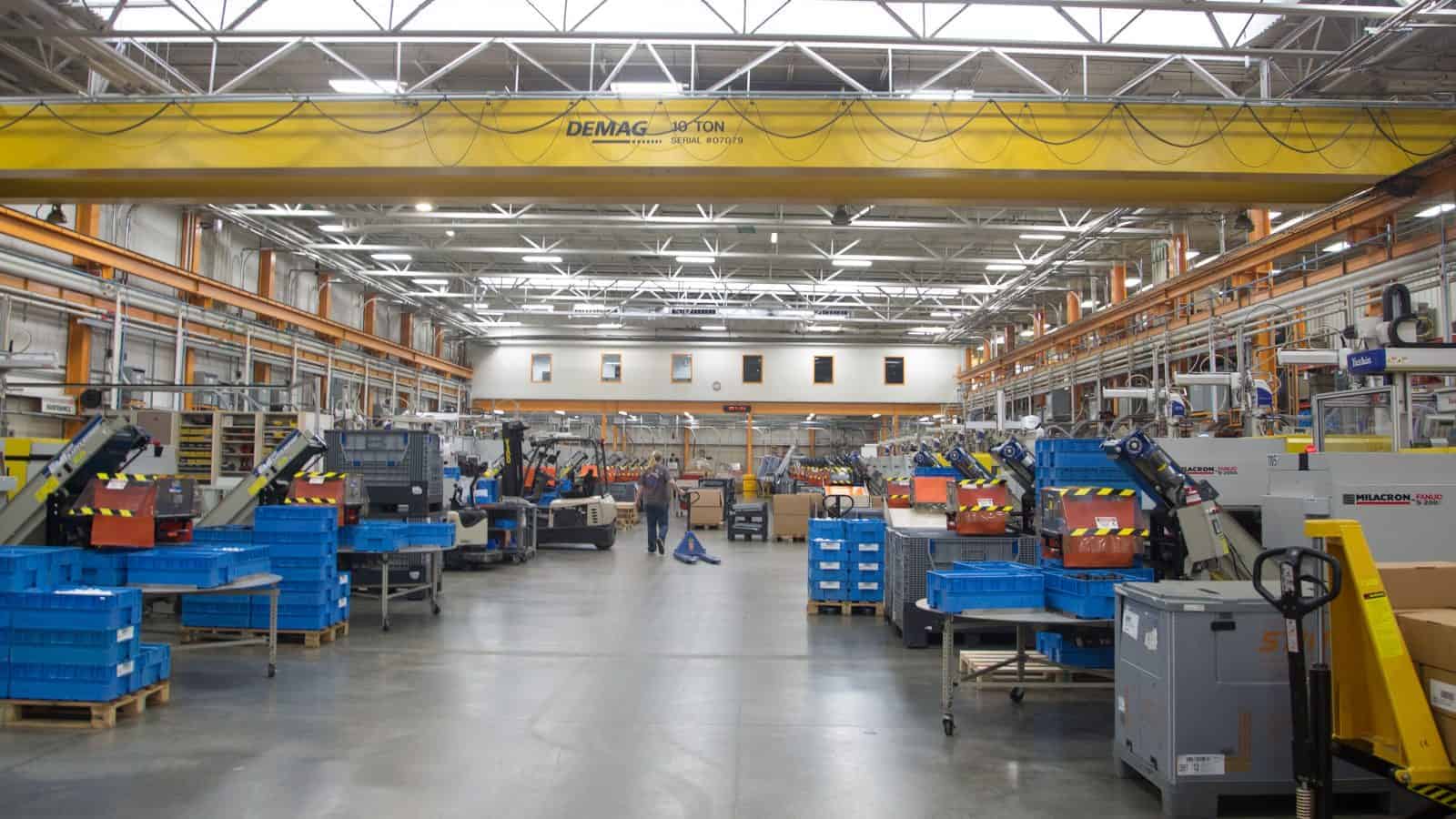Manufacturers Warn: PFAS Standards Threaten Industry and National Security
Washington, D.C. – Following the Environmental Protection Agency’s announcement on per- and polyfluoroalkyl substances in drinking water, National Association of Manufacturers President and CEO Jay Timmons issued the following response:
“We’re encouraged that the EPA has listened to the voices of manufacturers and extended the compliance deadline for unworkable national primary drinking water standards for PFOA and PFOS and committed to reconsidering the blatantly unlawful regulatory determinations for several other PFAS compounds.
“If the U.S. wants to stay a global manufacturing leader, we need practical, commonsense PFAS regulations. Manufacturers support science-based regulations that protect health and the environment and are in line with the Safe Drinking Water Act requirements. However, the Biden-era standards for PFOA and PFOS are deeply flawed, the costs they impose exceed any demonstrable benefit and the industries they harm include those vital to our national interests, including semiconductors, telecommunications and defense systems. The Pentagon has even raised alarms about long-term risks, including supply chain disruptions, that these standards would create.
“In addition to conflicting with manufacturers’ best interests, these standards also go against the Trump administration’s goal to make the U.S. the best place to build, grow and create jobs—a goal the administration is advancing by rebalancing regulations. The administration has done remarkable work to advance that goal, but today’s decision moves in the opposite direction.
“The decision runs counter to past efforts to cut red tape and boost manufacturing by putting shovels in the ground, more people to work, more products on the shelves and more prosperity into our communities. We don’t have to choose between supporting manufacturing and clean water in our communities.”
-NAM-
The National Association of Manufacturers is the largest manufacturing association in the United States, representing small and large manufacturers in every industrial sector and in all 50 states. Manufacturing employs nearly 13 million men and women, contributes $2.94 trillion to the U.S. economy annually and accounts for 53% of private-sector research and development. The NAM is the powerful voice of the manufacturing community and the leading advocate for a policy agenda that helps manufacturers compete in the global economy and create jobs across the United States. For more information about the NAM or to follow us on Twitter and Facebook, please visit www.nam.org.
It’s Infrastructure Week!

During United for Infrastructure’s Infrastructure Week, the NAM—an active member of the steering committee—participated in several events in Washington, D.C., highlighting the urgent need for permitting reform to accelerate U.S. building projects.
A reception: The NAM hosted a reception to kick off Infrastructure Week 2025 at its headquarters in partnership with United for Infrastructure, with special guest Sen. Shelley Moore Capito (R-WV), chair of the Senate Committee on Environment and Public Works.
- Nucor, Fluor Corporation and CRH sponsored the event.
A panel: NAM Vice President of Domestic Policy Chris Phalen spoke at the United for Infrastructure signature event, underlining the need for commonsense trade and permitting policies.
- “I think we can work with governments to address supply chain challenges,” he said when asked about tariffs. “We have a really important window of opportunity over the next 50 odd days to get some deals that provide zero tariffs on industrial trade. That is what manufacturers support.”
- “Manufacturers rely on transportation networks … to get our goods to and from ports to customers,” Phalen said regarding infrastructure, “but we also are making everything that goes into making transportation work, from aluminum to steel, from asphalt to aggregates, copper, circuitry and the large industrial machinery that builds [and] maintains roads, bridges, factories [and] power plants. So, it’s kind of a virtuous cycle where we’re investing in infrastructure.”
“Comprehensive manufacturing strategy”: Phalen also gave a brief overview of the NAM’s “comprehensive manufacturing strategy.”
- Revising the regulatory framework is a key priority, he said. “We’ve submitted dozens of letters to 10 separate federal agencies as part of President Trump’s deregulatory agenda. Manufacturers every year are spending $350 billion just to comply with federal regulations. And so we’ve been really pleased to see the start of this regulatory rebalancing from the administration.”
- Phalen cited moves including “reopening LNG export facility applications, rebalancing Clean Air Act rules … and streamlining and improving the process to improve new chemicals … at the EPA.”
- “Probably most important is permitting reform,” he added. “Manufacturers operate and employ and invest in the communities where we’re producing, so we don’t want to see any short-circuiting of public input. … [T]here does have to be recognition, though, that the way that things were set up in the late ’60s and early ’70s is hindering infrastructure of all kinds right now.”
A roundtable: The NAM also participated in a roundtable on continuing federal support for water infrastructure investments. NAM Director of Transportation, Infrastructure and Labor Policy Max Hyman shared perspectives on how these investments benefit manufacturers by driving demand for their products and providing an essential service for operations.
The last word: As NAM President and CEO Jay Timmons said during the reception, “Infrastructure is the foundation of manufacturing in the U.S.”
Send Your In-House Counsel to the Manufacturing Legal Summit!

Amid deep uncertainty about the legal and regulatory environment, attorneys in the manufacturing industry have an opportunity they won’t want to miss. The NAM Legal Center’s Manufacturing Legal Summit, scheduled for Nov. 12–14 in Washington, D.C., has opened registration this week.
The only conference crafted exclusively for manufacturing lawyers, the Summit attracts legal talent from companies of all sizes and sectors. Attendees learn about hot-button legal issues facing the industry, discuss best practices and make fruitful professional connections.
If you have in-house counsel who would benefit from this must-attend event, here’s what you need to know.
The details: This year, the fourth annual Manufacturing Legal Summit will focus heavily on the changes and trickle-down impacts brought about by the new Trump administration. Longtime NAM partner Foley & Lardner LLP will lead a session titled “Tariffs, Trade and Trump: Managing Supply Chain and Tariff Risks During an International Trade Tornado.” Other session topics include:
- Managing your workforce;
- M&A transactions in the manufacturing sector;
- PFAS and chemicals update;
- Administrative law under President Trump;
- AI, privacy and cyber; and
- Updates on the trial bar’s latest tactics.
The benefit: “What we hear consistently is that the opportunity to connect with others in the industry who are dealing with the same challenges is invaluable,” NAM Vice President and Deputy General Counsel of Litigation Erica Klenicki said following last year’s conference.
- “This was my first NAM Legal Summit, and I could not be more pleased with the topics presented, as well as the networking opportunities,” said Erin Tannock, compliance counsel for Viega LLC, about the 2024 Summit. “The content was relevant and current. I even had a few ‘aha’ moments! This event is worth the time, and I will be attending for years to come.”
Credits, too: An additional benefit of the conference is the potential to earn CLE credits, a professional requirement for attorneys. In 2024, attendees earned six or seven CLE credit hours for 32 different jurisdictions.
The last word: “In a year defined by uncertainty, the opportunity to benchmark with your manufacturing peers and the NAM legal team has never been so critical,” said Klenicki.
NAM to House: Regulate Proxy Firms, Protect Workers’ Retirement Savings

Congress should act now to ensure that manufacturers and manufacturing workers are protected from so-called “proxy advisory firms,” the NAM told House lawmakers this week at two congressional hearings.
Flaws abound: Proxy firms—powerful, unregulated entities that advise institutional investors on how to vote on proxy ballot measures at public companies—wield outsized influence and must be reformed, NAM Managing Vice President of Policy Charles Crain told the House Subcommittee on Capital Markets at a Tuesday hearing, “Exposing the Proxy Advisory Cartel: How ISS & Glass Lewis Influence Markets.”
- Proxy firms operate with undisclosed conflicts of interest, are unwilling to allow companies to review their draft reports, and are resistant to correcting mistakes in their final vote recommendations. Despite these flaws, proxy firms “still control a significant share of investors’ proxy votes—giving them sway over important corporate decisions,” Crain said.
- In 2020, after years of NAM advocacy, the Securities and Exchange Commission finally adopted a rule to rein in these powerful firms—yet today, proxy firms remain unregulated due to ongoing legal challenges and regulatory neglect.
- “The SEC’s 2020 rule has spent five years hung up in court,” Crain told the subcommittee. “The NAM has had to defend the rule across three separate cases—one of which has oral arguments scheduled for this Friday.”
SEC has authority: Although the largest and most influential proxy firm, Institutional Shareholder Services, “is now claiming in court that the SEC lacks the authority to regulate proxy voting advice at all,” the Securities Exchange Act of 1934 clearly provides the SEC the authority to regulate proxy solicitation, which includes the activities of proxy firms, the NAM said.
Tighten the reins now: “Even assuming that the NAM is successful in defending the SEC’s authority, there is more work for Congress to do,” Crain continued. This entails acting on six House bills that would:
- Create a comprehensive registration regime for proxy firms;
- Ensure that proxy firms remain subject to anti-fraud liability;
- Ban certain proxy firm conflicts of interest;
- Regulate the use of automated “robo-voting” systems;
- Ensure that investment managers carry out their fiduciary duties to their clients when hiring proxy firms; and
- Direct the SEC to conduct a thorough study on proxy firms and the proxy process.
Retirement savings in jeopardy: On Wednesday, Crain delivered a similar message for the House Subcommittee on Health, Employment, Labor, and Pensions at a hearing titled “Investing for the Future: ERISA’s Promise to Participants.”
- “More than 85% of manufacturing workers are eligible to participate in a workplace retirement plan. These Americans have probably never heard of a proxy firm, and they likely would be shocked to hear that their pension or 401(k) plan assets were being used in a way that could undermine their own retirement security,” Crain explained.
- But that’s exactly what’s happening when pension plan fiduciaries use “plan assets to pursue non-financial ESG goals—or blindly outsourc[e] the voting rights that come with those assets to unregulated and conflicted proxy firms,” he added.
- With their errors, conflicts of interest, political agendas, one-size-fits-all governance standards and more, proxy firms pose huge risks “to everyday Americans’ retirement security,” Crain said.
Manufacturers support guardrails: “That’s why manufacturers support appropriate guardrails to ensure that ERISA fiduciaries act in plan participants’ best interests when making investment and voting decisions,” Crain explained, adding that the Labor Department under the first Trump administration finalized rules to “do just that.”
- While the last administration largely rescinded those guardrails, Subcommittee Chairman Rick Allen (R-GA) recently introduced a measure that would require ERISA retirement plan fiduciaries to prioritize financial returns when making investment decisions on behalf of clients and to exercise closer oversight of proxy firms.
Stand up for workers: “Now is the time for Congress and the [Department of Labor] to stand up for these workers and ensure that ERISA plans are operating in their participants’ best interests,” Crain concluded.
In the news: Bloomberg (subscription) covered Crain’s testimony, as did Pensions & Investments (subscription) in two articles.
What’s next: As Crain previewed in his testimony, the NAM Legal Center will participate in oral arguments on Friday, May 2, before the U.S. Court of Appeals for the DC Circuit—arguing that the SEC has the authority to regulate proxy firms, and that the agency’s 2020 rule doing so was lawful.
- “Is this high stakes? Absolutely,” Crain told Bloomberg. “Is this the end of the fight if the NAM were to lose? No, it’s not.”
Timmons Presses for Comprehensive Manufacturing Strategy in NewsNation, FOX Business Interviews

In a one-on-one interview with NewsNation’s Blake Burman just hours before President Trump spoke at a town hall with the same network, NAM President and CEO Jay Timmons continued to underscore the need for a comprehensive manufacturing strategy to make long-term investments.
- “First and foremost, we have got to get those tax reforms from 2017—that rocket fuel that President Trump announced at our board meeting in 2017—renewed, and Congress needs to move that forward,” Timmons said.
- “Regulatory rebalancing is something that’s very important. It’s about $50,000 per employee per year in compliance costs; that’s pretty expensive. We also need energy dominance. [Trump is] well on his way to making that happen.”
- He added that we need “good, solid trade policy” so manufacturers don’t see added costs. “We’re waiting to see how all this comes out. And we’re hopeful.”
- “If you have a comprehensive manufacturing strategy that you’re implementing … that includes all of those things I just mentioned to bring down the cost of business doing business here in the United States, you absolutely will see more investment,” he continued. Trump “announced that $5 trillion has already been committed. You’ll see more jobs, and you’ll also see higher wages and benefits.”
The long view: “Massive facilities … take a little while,” Timmons told Burman. “That is a realization that I need Americans to understand.”
- Such sites typically take years, he said, with the exact number depending “on how localities and states are moving along the permitting process.”
- “I was George Allen’s chief of staff when he was governor of Virginia,” Timmons went on, “and he made a commitment that he was going to move large scale projects in a very expeditious way. And we had a huge chip manufacturer that made an announcement, and [the company] said the doors will open in one year. [T]hey did, and that’s because all of government was really focused on doing that. You’ve got that commitment from this administration, there’s no doubt about that, but it’s typically three to five years for a large-scale manufacturing operation to come to fruition, and you’re talking about a 30-year commitment.”
- “So that’s another reason we need permanence when it comes to tax policy and trade policy.”
FOX Business: Timmons recently spoke with a group of FOX Business reporters to discuss the comprehensive strategy needed from Congress, focusing specifically on tax, trade and the manufacturing workforce.
- In a story from that interview published today, he said: “The 2017 tax reforms that President Trump actually announced at our board meeting in 2017, [which he said] would be rocket fuel for the economy … indeed were. Those tax reforms led to record investment and job creation and wage growth for three years running after they were in enacted.”
NAM: Comprehensive Manufacturing Strategy Will “Ignite” Renaissance

The NAM’s comprehensive manufacturing strategy will be fundamental in “igniting the Industrial Renaissance of the United States,” the NAM told a House committee today ahead of a hearing of the same name.
What’s going on: “Manufacturers call on President Trump and Congress to implement a comprehensive manufacturing strategy that would create predictability and certainty to invest, plan and hire in America,” the NAM told the House Committee on Oversight and Government Reform.
- The purpose of the hearing was to examine how “cheap labor abroad, combined with overregulation and obstacles to permitting in the United States, contributed to the offshoring of American manufacturing and an overreliance on China to fulfill manufacturing needs.” It also emphasized “the importance of bringing manufacturing back to the United States.”
What we’re saying: The NAM has been advocating that the administration adopt a multipoint plan to see the manufacturing sector flourish. Today it urged President Trump and Congress to take the following actions from that strategy as soon as possible:
- Make 2017 tax reform permanent: Make permanent the pro-manufacturing tax measures scheduled to sunset at the end of 2025 and bring back already expired provisions. Failure to do so will put almost 6 million U.S. jobs at risk, according to a recent EY–NAM study.
- Rebalance federal regulations: Manufacturers now spend $350 billion a year to comply with federal regulations. That’s money that could be spent on factory expansions, hiring and/or wage raises, as NAM President and CEO Jay Timmons has pointed out. The NAM also recently urged 10 key federal agencies to revise or rescind dozens of onerous, anachronistic regulations.
- Expedite permitting reform: “America should be the undisputed leader in energy production and innovation, but we will not reach our full potential without permitting reform.” This must include expediting judicial review, accelerating the permitting process, creating enforceable deadlines and more.
- Implement commonsense trade policies: “Building things in America only works if we can sell them around the world,” the NAM told the House members. “That is why manufacturers urge President Trump and Congress to provide greater predictability and a clear runway to allow them to adjust to new trade realities, while also making way for exemptions for critical inputs, enabling reciprocity in manufacturing trade.”
Manufacturers to Federal Agencies: Rebalance Regulations to Strengthen Manufacturing in the U.S.
The NAM Backs President Trump’s Executive Order 14219 with Policy Proposals to Reconsider Dozens of Costly Regulations Stifling Growth and Jobs
Washington, D.C. – In response to the President’s call for industry input on a new era of balanced, sensible and pro-growth regulation, the National Association of Manufacturers submitted recommendations to key federal agencies highlighting dozens of burdensome and outdated regulations that are driving up costs and undermining manufacturing competitiveness.
“Rebalancing regulations is a critical pillar of our comprehensive manufacturing strategy—which also includes making the 2017 tax reforms permanent, expediting permitting reform to unleash American energy, strengthening the manufacturing workforce and implementing commonsense trade policies,” said NAM President and CEO Jay Timmons. “Manufacturers are spending $350 billion each year just to comply with federal regulations—money that could be spent on expanding factories and production lines, hiring new workers or raising wages. The administration is already answering the calls of manufacturers across the country to reconsider and rebalance regulations that are holding manufacturers back. Using these recommendations as a guidepost, manufacturers look forward to continuing to work with the administration to fix rules that cost too much, trap projects in red tape, chill investment, do not make sense and harm the 13 million men and women who make things in the United States.”
The NAM has identified at least 44 regulations across 10 agencies that the Trump administration should consider revising or rescinding under Executive Order 14219, “Ensuring Lawful Governance and Implementing the President’s ‘Department of Government Efficiency’ Deregulatory Initiative.” Today’s action builds on the momentum of a December 2024 letter from the NAM and more than 100 manufacturing organizations to the transition team detailing regulatory actions the incoming administration could take to right-size regulations that stunted manufacturing growth and job creation. The administration has acted decisively on key manufacturing priorities already: lifting the liquefied natural gas export ban on day one, rescinding Securities and Exchange Commission Staff Legal Bulletin 14L in February and announcing in March that it plans to revise the Environmental Protection Agency’s PM2.5 and Power Plants rules.
The NAM’s submissions in response to EO 14219 target burdensome regulations at the following agencies: the EPA, SEC, Department of the Interior, Department of Energy, Department of Labor, Cybersecurity and Infrastructure Security Agency, Department of Health and Human Services, National Institute of Standards and Technology, Federal Trade Commission and Department of the Treasury.
Background:
EO 14219, issued on Feb. 19, directs federal agencies to conduct a top-to-bottom review of existing regulations within their jurisdiction and identify, within 60 days, those that impose significant costs that outweigh their benefits; exceed statutory authority; disproportionately hurt small businesses; or impede innovation, R&D, economic development and more.
-NAM-
The National Association of Manufacturers is the largest manufacturing association in the United States, representing small and large manufacturers in every industrial sector and in all 50 states. Manufacturing employs nearly 13 million men and women, contributes $2.93 trillion to the U.S. economy annually and accounts for 53% of private-sector research and development. The NAM is the powerful voice of the manufacturing community and the leading advocate for a policy agenda that helps manufacturers compete in the global economy and create jobs across the United States. For more information about the NAM or to follow us on Twitter and Facebook, please visit www.nam.org.
Tariffs: 1930 Versus 2025

The U.S. stock market saw its worst day yesterday since the early days of the pandemic, following President Trump’s latest round of tariffs. These tariffs, when combined with other U.S. tariffs in 2025, make the U.S. average effective tariff rate 22.5%—the highest rate since 1909, according to The Budget Lab at Yale.
Manufacturers already had record-high concerns about trade uncertainties before this latest announcement, as the NAM’s Q1 Manufacturers’ Outlook Survey found. Now, the uncertainty and instability have only increased, reminding observers the last time the U.S. imposed sweeping tariffs—with disastrous consequences.
Back then: The Tariff Act of 1930, also known as the Smoot-Hawley Act, was signed into law by President Herbert Hoover. Originally intended to protect the U.S. agricultural industry, it was later expanded to cover a broad swath of the U.S. economy, as CNBC recounts.
- The Smoot-Hawley Act imposed tariffs on approximately 25% of all imports to the U.S., according to Santa Clara University economic historian Kris James Mitchener.
- Some sounded the alarm at the time. Before signing the law in June 1930, President Hoover received “a petition signed by more than 1,000 economists asking him to veto the bill.”
A spiral: “Smoot-Hawley raised the average tariff on dutiable imports to 47% from 40%, [Dartmouth economist Doug] Irwin said. Depression-era price deflation ultimately helped push that average to almost 60% in 1932, he added.”
- Compare that to now: the latest tariff rates will be higher than the Smoot-Hawley levels, as reported by CNBC .
Manufacturers hurt: Following the passage of Smoot-Hawley, Argentina, Australia, Canada, Cuba, France, Italy, Mexico, Spain and Switzerland all responded with retaliatory tariffs on U.S. goods. These tariffs often fell on manufactured products, weakening the sector amid the economic catastrophe of the Depression.
- For example, France, Spain, Italy and Switzerland increased tariffs on American cars, effectively closing off those markets to major American exports.
- In all, “U.S. exports to retaliating nations fell by about 28% to 32%, said Mitchener. Further, nations that protested Smoot-Hawley also reduced their U.S. imports by 15% to 23%.”
Long-lasting pain: The Dow Jones Industrial Average slid following the imposition of the tariffs, bottoming out in July 1932.
History lesson: Smoot-Hawley has long been condemned by American leaders of both parties as a mistake that severely damaged the American economy.
- Before taking office, Roosevelt denounced the Smoot-Hawley Act, saying it “compelled the world to build tariff fences so high that world trade is decreasing to vanishing point.” He would sign the Reciprocal Trade Agreements Act, which reduced tariffs with trading partners on a reciprocal basis, in 1934.
- When President Ronald Reagan spoke to the NAM’s Annual Meeting in 1986, he said, “I well remember the antitrade frenzy in the late twenties that produced the Smoot-Hawley tariffs, greasing the skids for our descent into the Great Depression and the most destructive war this world has ever seen. That’s one episode of history I’m determined we will never repeat.”
Modern realities: President Trump has insisted that “we’re bringing wealth back to America” through these sweeping tariffs (CNBC). But manufacturers are urging caution, especially when future tax policy is so uncertain.
- One family-owned U.S. textile manufacturer, founded in 1887, warns that tariffs will dramatically raise the prices of its components, such as fabric, thread, yarn and fiber—none of which it can source in the U.S. “Tariffs would force us to curtail employment or close facilities if our customers would not accept higher prices,” the company said.
- Another manufacturer, an employee-owned firm, makes products and systems that control, monitor and protect utility and industrial electric power systems—which is critical for the coming buildout of new power generators and the electrical grid to meet the demand for AI datacenters. Tariffs will materially harm its ability to enable this essential economic growth.
- A third manufacturing company, a 100-year-old Wisconsin company specializing in custom-designed thermal solutions and large-scale HVAC cooling systems used in agriculture, mining, oil and gas and more, says that “tariffs on Canada and Mexico could cause us to take cost-cutting measures, including workforce reductions.”
- Last, a manufacturer that has made chemicals in the U.S. since the late 1800s reports that tariffs may set back its plans for expansion in North America, “which is already five times more expensive for us than in Asia and three times more expensive than in Europe.” The company will be less able to support crucial semiconductor manufacturing, and may even have to close low-margin business lines in the U.S.
The last word: “[M]anufacturers are scrambling to determine the exact implications for their operations [of the April 2 tariffs],” NAM President and CEO Jay Timmons said on Wednesday. “The stakes for manufacturers could not be higher. Many manufacturers in the United States already operate with thin margins. The high costs of new tariffs threaten investment, jobs, supply chains and, in turn, America’s ability to outcompete other nations and lead as the preeminent manufacturing superpower.”
Manufacturing Wins: J&J Invests More Than $55 Billion

Johnson & Johnson will spend more than $55 billion on manufacturing, research and technology in the U.S. over the next four years, the biopharmaceutical company announced (Axios). These investments include a long-planned $2 billion state-of-the-art biologics facility in Wilson, North Carolina.
What’s going on: The NAM joined J&J for the groundbreaking of the 500,000-square-foot biologics manufacturing plant in Wilson on Friday.
- The White House praised the announcement and J&J’s commitment to manufacturing in America. North Carolina Gov. Josh Stein and Rep. Don Davis (D-NC) also attended the ceremony to highlight the facility’s importance to the state economy and the jobs it will bring to the state.
Other projects across the total investment will include:
- Three new advanced manufacturing sites and the expansion of several facilities in J&J’s Innovative Medicine and MedTech businesses;
- Significant spending on research-and-development infrastructure “aimed at developing lifesaving and life-changing treatments in areas such as oncology, neuroscience, immunology, cardiovascular disease and robotic surgery,” according to the company; and
- More investment aimed at speeding drug discovery and development, supporting workforce training and improving business operations.
Common goal: The Wilson site demonstrates the power of collaboration, Johnson & Johnson Executive Vice President and Chief Technical Operations & Risk Officer and NAM Board Chair Kathy Wengel said at the groundbreaking.
- “Today is a tangible example of how J&J is bringing communities, government, education and industry together to achieve the common goal of creating a future-ready workforce that is ready to tackle the toughest health challenges and achieve new breakthroughs.”
Why it’s important: The investments will strengthen not only North Carolina’s economy, but the U.S. economy as a whole, NAM President and CEO Jay Timmons said at the event.
- “Every $1 invested in manufacturing adds more than $2.60 to the economy. That’s top-of-the-line ROI for communities, neighborhoods and cities like Wilson—among the best ROIs you can get. And every new manufacturing job supports, on average, five additional jobs in other industries.”
The big picture: The new Wilson facility will generate a $3 billion impact across North Carolina in its first decade of operation.
- It will support about 5,000 jobs during construction and create more than 500 permanent positions—paying an average of $109,000 a year—in the state (WRAL News).
Certainty and predictability: These investments illustrate why policymakers must ensure that manufacturers have more certainty and predictability, not less, Timmons added.
- “Manufacturing—especially biopharmaceutical manufacturing—requires years of planning, ingenuity and investment decisions,” he said. “When there’s stability, common sense and competitive policies, companies like Johnson & Johnson can plan for the future—and plan big.”
- Timmons said that to “make more wins like this happen,” elected officials must stay focused on a comprehensive manufacturing strategy, including a “competitive tax policy, balanced regulations, prompt permitting, abundant energy and smart trade policies.”
The tax factor: J&J credits the 2017 Tax Cuts and Jobs Act with allowing it to increase its investment, according to MassDevice.
- Investments like J&J’s “are why it is critical that pro-growth provisions of the 2017 tax law be made permanent and more competitive,” Timmons wrote in a social post. “If Congress fails to act, 6 million American jobs—184,000 in North Carolina—will be wiped out. We can’t let that happen.”
- But if Congress does preserve the measures, manufacturing will win, Timmons said. “And when manufacturing wins, America wins.”
Critical Minerals Executive Order Strengthens U.S. Manufacturing

President Trump’s recent executive order to accelerate permitting and access to domestic critical minerals will help manufacturing—and America—win, NAM President and CEO Jay Timmons said.
What’s going on: The recent executive order aims to boost U.S. production of critical minerals—which include lithium and cobalt—“as well as uranium, copper, potash, gold and any other element, compound or material as determined by the Chair of the National Energy Dominance Council,” according to the EO.
- China dominates the global market for critical minerals, which are vital in the manufacture of everyday goods from cell phones and computers to advanced energy and defense technologies.
- Increasing American production of these crucial substances “can create jobs, fuel prosperity and significantly reduce our reliance on foreign nations,” according to the EO. “Transportation, infrastructure, defense capabilities and the next generation of technology rely upon a secure, predictable and affordable supply of minerals.”
What’s in it: The EO—which cites “overbearing federal regulation” for the lack of American critical mineral production—enumerates “staggered timelines for agencies across government to prioritize financing for domestic mineral projects, including loans, capital and technical assistance, and calls on the Department of Defense to accelerate domestic mineral production” (POLITICO Pro’s GREENWIRE).
- It also calls on the DOD to work with the U.S. International Development Finance Corporation to offer financing for the projects.
Aligned on regulations: The NAM has long called for regulatory reform to combat the onslaught of rules coming from the federal government—and this EO is a much-needed reform, said Timmons.
- “For too long, red tape and burdensome regulations have stood in the way of the basic building blocks that power manufacturing in the United States, especially mining and processing the minerals manufacturers rely on to create jobs and dominate on the world stage,” Timmons said. “The administration is addressing those barriers, making it easier for manufacturers to access the resources we need to build the future in America.”
